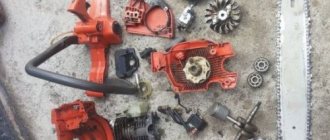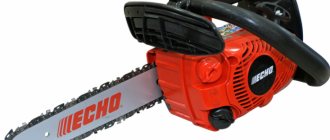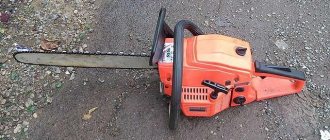If you are looking for a chainsaw that will serve you for years, then this should be the Taiga. It is very popular in the domestic market and has not lost its popularity over the many years of its production. It captivates customers with its ease of operation, high maintainability, excellent quality and reliability. And these are not all the features of this tool.
The range of such equipment allows everyone to choose a saw for their purpose. Either it will be a tool for home use (garden care, lawn care, minor construction work) or a semi-professional unit for felling trees and bucking wood. To make it easier for you to choose a Taiga chainsaw, we will give a brief overview of the most popular models.
Chainsaw Taiga 214
This tool is in great demand due to its durability and reliability. It is successfully used in public utilities, construction, and households. The design of such equipment makes it easy to cope with cutting wet and freshly cut wood. In addition, the saw will show excellent results when performing work such as:
- bucking of whips;
- cutting down small trees;
- croaker filing;
- pruning;
- firewood preparation;
- sawing old boards.
Technical characteristics of Taiga 214:
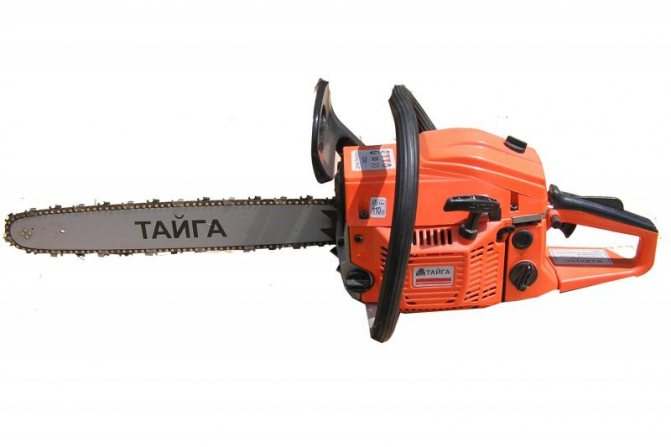
- power: 3.5 hp
- engine: 2-stroke
- tire length: 38 cm
- fuel consumption: 440 g/l.h.h
- engine volume: 75 cm3
- oil tank: 0.25 – 0.3 l
- weight: 8.8 kg
- dimensions: 857x280x272 mm
- fuel tank: 0.8 l
- noise level: 106 dB
Features of the Taiga 214 chainsaw:
- good performance;
- endurance;
- reliability;
- automatic oil supply;
- comfortable work with the tool;
- high maintainability.
Troubleshooting Taiga 214
Many owners of such saws do the adjustment and repair of the equipment themselves. It's not that difficult, the main thing is to do everything according to the instructions. Now we will tell you how to fix the most common breakdown of the Taiga 214 chainsaw.
What to do if the engine does not start?
- Check if there is fuel in the tank.
- Check for spark.
- Check for fuel leaks.
- Clean the fuel filter.
- The presence of a spark and a wet spark plug indicates low-quality fuel. In this case, you need to adjust the carburetor.
How to adjust the carburetor?
- We carry out adjustments during the break-in period. To do this you need to take a small slotted screwdriver. If this is a primary adjustment, then it must be done with the chainsaw turned off. And if the final one is warmed up and running.
- Screw “X” – idle speed adjustment screw. Screw “P” – low speed adjustment screw. And the one that remains is responsible for power and quantity at maximum speed.
- During the initial adjustment, the high and low speed screw is set completely from the screwed state to position 1¼.
- We start the chainsaw and warm it up.
- We make final adjustments to the screws until we get maximum power and speed.
Design and principle of operation
Carburetor. This is a device in which fuel (gasoline) and air are mixed in specified proportions and then the finished mixture is fed into the engine cylinder. Almost all models of chainsaws have the same type of carburetors, so the design and operating principle are the same.
The main elements of the carburetor design are:
- Body which is cast in aluminum to reduce weight. Chainsaws are constantly moved from place to place and are held in hands while working, so reducing tool weight is a priority for manufacturers;
- Diffuser with an air damper located at the inlet;
- Jets , presentation of valves for metered fuel supply;
- Spray , ensuring the injection of gasoline into the chamber (in the diagrams it is designated as the main nozzle);
- Fuel (float) chamber.
READ Husqvarna Chainsaw Does Not Gain Speed Reason
Figure 1. Diagram of a carburetor chainsaw
The operating principle of a carburetor can be described as a cycle consisting of the following stages:
- The choke valve opens when the engine starts.
- The stroke of the piston creates a vacuum in the air channel, as a result of which air enters the diffuser, the amount of which is regulated by the position of the air valve.
- From the gas tank, gas enters the float (fuel) chamber. The speed of its entry is controlled by nozzles.
- Gasoline and air are mixed in the diffuser, resulting in the formation of an air-fuel mixture, which then enters the engine cylinder. The more mixture enters the combustion chamber of the cylinder, the higher the power and speed at the engine shaft.
Chainsaw Taiga 245
Taiga 245 is a universal professional chainsaw that is characterized by high performance. The main features of such equipment is the presence of a professional anti-vibration system. It is worth noting the high maintainability of the tool and durability in operation. Of course, these advantages contributed to the popularity of this equipment.
Technical characteristics of the Taiga 245 saw:
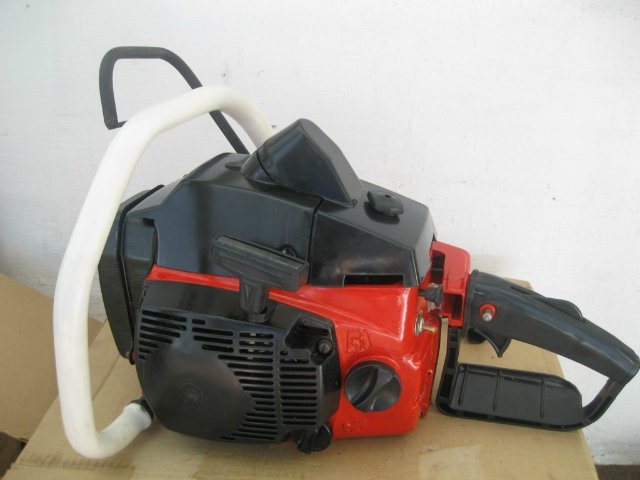
- weight: 9 kg
- fuel tank: 700 – 800 ml
- oil tank: 260 ml
- starting system: manual starter
- fuel consumption: 600 g/kW h
- tire length: 40 cm
- engine volume: 45 cm3
- noise level: 105 dB
- engine: 2-stroke
- power: 3.5 hp
Such a saw will be an excellent assistant more at home than for working in the forest. Quite a lot of weight interferes with long-term uninterrupted operation. Nevertheless, it is quite easy to find spare parts for such a unit.
Chainsaw Taiga BP 3650
This model is one of the modern reliable chainsaws presented at an affordable price. The BP 3650 can easily cope with a number of tasks such as: cutting down dead wood, branches, bushes, preparing firewood, felling small trees. The saw is lightweight and easy to operate, has an ergonomic design, and is reliable.
Key features of the saw:
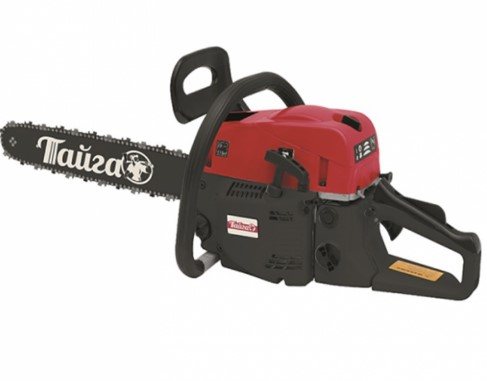
- high-performance engine;
- presence of an automatic lubrication system;
- high chain speed;
- the presence of overheating protection;
- chrome-plated cylinder walls;
- anti-vibration system;
- adjustable oil pump;
- emergency chain brake.
Specifications:
- engine power: 4.9 hp
- weight: 6.3 kg
- engine: 2-stroke
- tire length: 45 cm
- fuel tank: 0.55 l
- oil tank: 0.26 l
- engine volume: 52 cm3
- starting system: manual starter
Overview of the characteristics of various modifications
The model under consideration has long proven itself on the positive side. This reliable and powerful tool is used in the forestry sector and for household needs. Since most of the parts of the unit are made of metal, the saw has a relatively large mass (9 kg).
The device operates using a two-stroke power unit, the working volume of which is 75 cubic centimeters with a power of 2.6 kW. The motor is equipped with a built-in cylinder with a diameter of 5 centimeters. A distinctive feature of this modification is the special composition of the fuel mixture (0.5 parts of motor oil are used for 10 parts of AI-92 gasoline).
The working chain is lubricated with the same oil, in warm weather - in its pure form, and in winter in a ratio of one to four with gasoline. The ZID Taiga-245 chainsaw has the following overall dimensions in length, width and height: 900x280x300 mm. The working part consists of a 400 mm bar and a chain with a pitch of 9.3 mm.
The Taiga chainsaw, reviews of which are mostly positive, has a cantilever-type saw part, which includes a bar, chain and drive sprocket. Lubrication during operation occurs continuously in automatic mode, provided by a plunger pump. The supply unit and oil reservoir are located on the motor body. The pump is driven by a worm gear; no additional adjustment of the tool is required.
In warm weather, the same oil is used to lubricate the working part and the fuel mixture. In the cold season, it is diluted with gasoline in a ratio of one to three. The sleeve on the tire is connected to the oil tank and the guide groove through specially provided holes. Oil is supplied through the gearbox input shaft, which drives the plunger.
The Taiga line of chain units includes the following units:
- for home use (low power operation, up to 1.7 kW);
- semi-professional (work at medium power, up to 3 kW, with intensive regular operating loads);
- professional (work at high power, up to 6.5 kW);
- Gasoline sawmills Taiga with autonomous engines and maximum efficiency of lumber output (operation at power up to 20 kW).
The technical characteristics of the Taiga chainsaw meet safety requirements; the design has a large strength margin and resistance to any load.
Taiga-214
The Taiga-214 chainsaw is characterized by:
- long battery life;
- low fuel consumption;
- ability to saw trees with a diameter of up to 30 cm;
- stability of traction performance;
- automatic oil supply by a plunger type pump.
Chain unit parameters:
- 2-stroke engine power - 2.5 kW;
- cylinder volume - 65 cm³;
- tire length - 38 cm;
- oil tank - 0.25-0.3 l;
- fuel tank - 0.8 l;
- weight - 8.8 kg;
- dimensions - 857x280x272 mm.
In comparison with the Taiga-245 chainsaw, the technical characteristics of which include more powerful parameters, the 214 model is unpretentious to fuels and lubricants.
Taiga-245
The chain model Taiga-245 of the semi-professional class, due to its low fault tolerance, has not found wide distribution on a production scale, but due to its high productivity and the ability to perform sawing of any complexity, it is used in everyday life. It has the following features:
- heavy weight, about 9 kg;
- starting system with a manual starter, stopping with a toggle switch;
- simplified adjustment of a floatless carburetor with a built-in pressure regulator and booster diaphragm pump;
- ignition advance from magneto EM-2 AM-17V;
- ability to fell trees with a volume of 0.35 m³.
Additionally: Chainsaw carburetors all types of videos
Technical characteristics of the Soviet saw Taiga-245:
- chainsaw power - 2.6 kW;
- engine type - 1-cylinder 2-stroke;
- fuel tank capacity - 0.7-0.8 l;
- oil tank capacity - 0.25-0.35 l;
- productivity - 70 cm²/s;
- Fuel consumption at maximum power is 600 g/kW*h.
The saw set includes:
- universal chain with a pitch of 9.3 mm;
- saw bar 40 cm long.
Taiga-3850
Chainsaw BP-3850 is a 3.85 kW unit with the following equipment:
- quick start system at low ambient temperatures;
- booster pump;
- saw bar 45 cm long;
- automatic chain lubrication system;
- anti-vibration system;
- adjustable oil pump;
- overheating protection mechanism;
- chrome plating of the cylinder working surface.
The manufacturer equipped the tool with a 2-stroke engine with a displacement of 52 cm³ and a rotation speed of 9000 rpm. Saw weight: 5.3 kg.
Refill containers:
- fuel tank - 0.55 l;
- lubricant tank - 0.26 l.
Technical and operational parameters of the professional chainsaw Taiga-4000:
- power - 4 kW;
- idle speed (idle) - 2800 rpm;
- working volume - 58 cm³;
- tire length - 45 cm;
- chain pitch - 0.325";
- fuel tank capacity - 0.55 l;
- volume of the chain lubrication tank - 0.26 l;
- weight - 7.6 kg.
The main advantages of the model are:
- increased motor life;
- made of shockproof plastic;
- presence of a nylon filter;
- rich equipment - 2 tires of 72 links and 2 chains of 18".
Taiga-4500
The 4500 Series gasoline unit is equipped with a centrifugal air cleaning system and an inertia-type emergency stop mechanism, which reduces the likelihood of a kickback causing injury.
The model 4500 differs from the previous TBP-4000 saw only in its power increased by 500 W. The design, color and performance are similar.
Taiga-6300
The Pro class gasoline tool TBP-6300 has a high degree of assembly based on a 6.3 kW 2-stroke power plant, is equipped with a chrome-plated piston group and 2 compression rings, a carburetor with a primer and a kick starter with an easy start system.
The length of the guide bar is standard and is 45 cm. The basic package includes;
- 2 tires;
- 2 chains;
- a set of keys;
- measuring cup.
Chainsaw Taiga TBP 4500
Excellent quality, maneuverability and ease of use - all these qualities are easily combined in the Taiga 4500 chainsaw model. It is capable of coping with both household work, construction and felling trees in the forest.
Thanks to its fairly light weight and balanced design, working with such a tool is comfortable and easy.
Distinctive features of such equipment are:
- low noise;
- increased engine resource;
- emergency circuit installation;
- high power;
- adjustable oil pump.
Specifications:
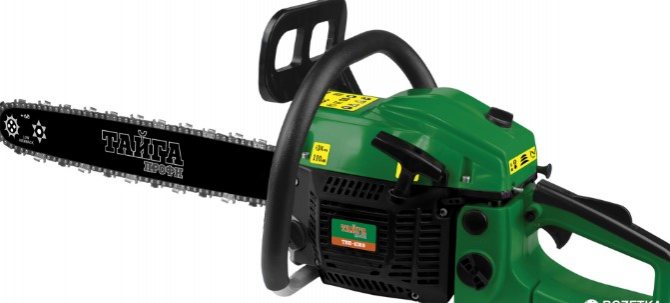
- engine volume: 58 cm3
- fuel tank: 550 ml
- oil tank: 260 ml
- weight: 6 kg
- tire length: 45 cm
- engine: 2-stroke
- starting system: manual starter
Taiga chainsaws will delight you with their quality and endurance. They are very easy to use and have good maneuverability and an affordable price. Be sure to read the instructions in detail before starting to work with such a tool and follow all safety precautions when working.
How to adjust the carburetor with your own hands?
After washing and thoroughly cleaning the carburetor, they are assembled and begin to be adjusted. First of all, you need to understand the purpose of the adjustment screws. This will help the instructions, but some general points should be addressed immediately. The most common screw designation is:
- N. _ Regulates the state of the main jet, i.e. Sets the maximum rotation speed of the motor shaft;
- L. _ Regulates idle nozzles (responsible for the minimum shaft rotation speed);
- T. _ Regulates engine idle speed. It can also be marked with the letters LA or S; on some carburetor models it is completely absent.
Turning screws H and L clockwise depletes the air-fuel mixture and enriches it counterclockwise (the amount of gasoline increases). When screw T rotates, the shaft rotation speed changes at idle speed. Clockwise, it increases and decreases in the opposite direction.
READ Review of Broached Miter Saws
Figure 2. Carburetor adjustment mechanisms
Before taking direct action, it is necessary to find and carefully study information about the position of the adjusting screws (the value of the angle of rotation during adjustment). This information is available in the chainsaw manual. Then you need to prepare your workplace. Lay the saw on a flat, horizontal plane with the chain facing away from you. Remove all covers, foam and air filter. At this point, the preparatory operations are considered complete, and the main part of the work can begin.
Procedure for setting carbohydrates:
- Carefully tighten screws H and L clockwise until they are tight, being careful not to break the screws. This will result in complete loss of the carburetor.
- Unscrew both screws one and a half turns.
- Run the engine for 10 minutes and warm it up. This is a necessary point because the carburetor cannot be installed correctly on a cold engine.
- By turning screws H and L, alternately adjust the rotation of the shaft at maximum and minimum speeds.
- By adjusting the position of screw T (or it may have another designation), the idle speed of the chainsaw is adjusted. It is necessary to achieve smooth and stable operation of the engine. It is important to monitor whether the circuit is in standby mode or not. If it moves, turn the screw slightly counterclockwise.
Check engine operation visually and audibly. A mixture that is too rich results in thick smoke from the exhaust. When a lean mixture is fed while the saw is running, a whistle is heard. Excessive saving is harmful. If you set the L screw to "bad" fuel, you will have problems starting the engine. When set to a lean mixture, screw H will noticeably lose strength. You can determine the correct setting by the following criteria:
- At idle, the engine does not lag and the chain does not move;
- There is no excess smoke from the exhaust pipe when the engine is running;
- The engine exhibits good throttle response (it quickly picks up speed when you press the accelerator).
A detailed description of the setup is available in the instructions included with the instrument in the package. This should be carefully reviewed as there may be some features or special requirements set by the manufacturer that only apply to that model of saw. If all requirements are met accurately, the chainsaw's performance will be restored to its original condition.



